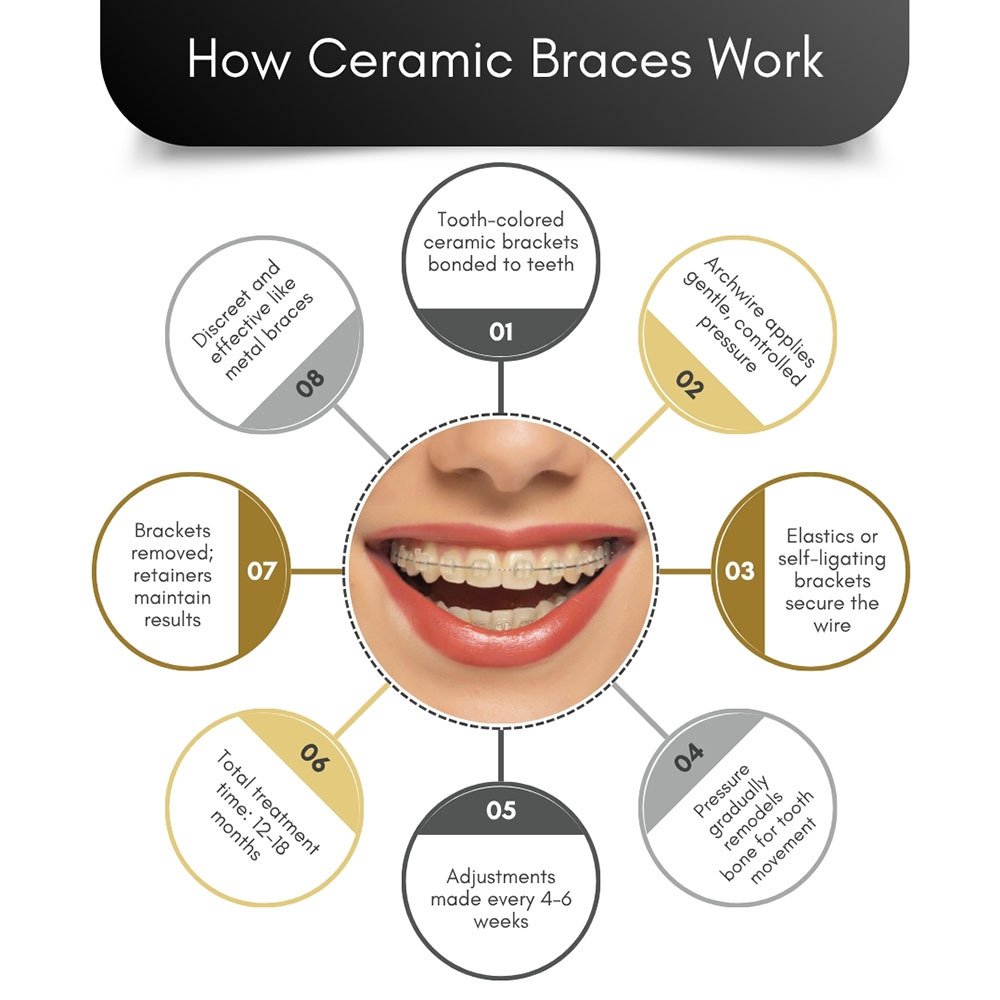What Are Ceramic Braces?
Originally introduced during the 1980s, so braces have brackets made from aluminum oxide, giving them a clear or tooth-colored appearance. The material is very hard, so ceramic braces are quite durable. However, this hardness can increase the brittleness of the material.
How Do Ceramic Braces Work?
Like metal braces, the system uses brace brackets bonded onto your teeth. These brackets are controlled by archwires and elastics bands or ligatures that increase the tension on the wires. They work similarly to traditional teeth braces, putting specific teeth under pressure so they are pushed or pulled into the proper places.
Not all ceramic braces need elastics. For example, Damon braces have self-ligating brackets, so treatment is elastic-free, and the braces have a more streamlined appearance.
Ceramic braces are a popular option, but like every system, they have advantages and disadvantages compared with other systems.
Ceramic braces pros and cons are compared with other systems and are discussed below.

“ Best dental office hands down! My son and i came here regularly for my cleanings. I also just got my braces taken off. In love with my new smile! The staff is always so welcoming and will do everything in their powers to make you comfortable. Bella did my braces and always just a phone call away when I ever had any questions regarding my treatment.“

Jasmine Julien Invisalign Patient
Ceramic Braces vs Metal Braces
Both ceramic and metal braces work similarly as they are fixed onto teeth for the duration of treatment. However, there are some differences between them, which are outlined below.
Visibility
Ceramic braces are undoubtedly less visible than metal ones, especially if you have a ceramic brace with tooth-colored wires. Ceramic braces are available in a huge range of different shades or have clear brackets.
Cost
Ceramic braces will cost more than metal braces. The materials used are more expensive, and the cost difference can be considerable.
Oral hygiene
Because ceramic brackets can be larger than metal brackets, you might find them harder to clean around. If you cannot clean around the brackets effectively, your gums will become swollen and more sensitive or start to recede.
Treatment Times
Ceramic brackets are more fragile than metal, so your treatment may progress more slowly. Our orthodontist at Brooklyn Invisalign Center may need to make smaller incremental adjustments at each appointment than if you were wearing metal braces.
On the plus side, this may mean that treatment is slightly more comfortable than metal braces as the changes at each appointment will not be so large.
Allergies
Some people have allergies to metals used in dentistry. The most common allergy is to nickel. Most of the metal alloys used in orthodontics contain nickel. Having ceramic braces can reduce these allergic reactions.
Ceramic Braces vs Invisalign
While ceramic braces are fixed, Invisalign is a removable aligner system, so each works quite differently.
Visibility
Both braces are discreet, but you are more likely to notice ceramic brackets and wire than Invisalign’s clear plastic aligners.
Depending on your dietary habits, there might be a risk that the ceramic brackets become stained. Invisalign aligners are removed for meals, so they should not stain due to your dietary choices.
If discretion is important, investigate Invisalign first to see if it will suit you.
Effectiveness
Ceramic braces, like metal braces, are suitable for more complex tooth movements. Although aligner systems like Invisalign can increasingly cope with complicated tooth corrections, there are still occasions when fixed braces like incognito lingual are better.
Oral Hygiene
Fixed braces are trickier to clean around, and you must use special tools to thoroughly clean your ceramic brackets and wires after each meal.
Invisalign aligners are simpler to care for since you remove them for oral care so that you can follow your normal routine.
Costs
The costs for ceramic braces and Invisalign may be similar. It all depends on your treatment plan and the issues needing correction.
Dietary Changes
You will need to change your dietary habits with ceramic braces. Eating hard, sticky, or crunchy foods could damage or break your braces. These foods can also be tricky to remove.
Invisalign requires no dietary changes since you take out the aligners for meals and when drinking anything other than water.
What Our Patients Are Saying
Are Ceramic Braces Right for You?
Ceramic braces offer a discreet way to straighten teeth and can complete precise tooth movements that could be beyond the scope of removable braces like Invisalign. However, they are more expensive than metal braces and the ceramic material is more fragile. Another option is clear braces made with fully transparent components, offering an even more discreet look than ceramic braces.
We can discuss all the possible pros and cons further when you visit our dental office. If we suggest ceramic braces as a possible treatment option, there are some things that you can do to ensure treatment is more successful.
- Ensure you brush and floss after every meal. The more often you remove food debris and dental plaque, the lower the risk of staining.
- Avoid foods that could discolor your ceramic braces. These include coffee, tea, wine, soda, and acidic foods like tomatoes.
- Quit smoking, as the nicotine can cause yellow stains on braces.
- If you play sports, get a custom mouthguard that fits over your braces to protect them and your teeth during sports.
Additional Orthodontic Services We Offer
- Emergency Orthodontics
- Orthodontic Palate Expanders
- Teen Braces
- Invisible Braces
- Clear Braces
- Retainers (Fixed & Removable)
If you opt for ceramic braces and they become stained, we can replace these stained components during your regular checkups with our orthodontist. Contact Brooklyn Invisalign Center at (718) 375-3757 to book a consultation.

